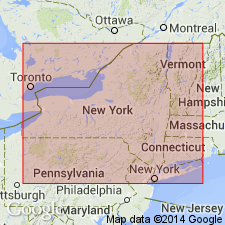
- Usage in publication:
-
- Cornwall limestones
- Modifications:
-
- Original reference
- Dominant lithology:
-
- Limestone
- AAPG geologic province:
-
- Appalachian basin
Summary:
Pg. r148. Cornwall limestones. A series of thin beds of limestone overlies Longwood shales at several points in Orange County, southeastern New York. Beds carry fossils which correlate them with Lower Helderberg and Waterlime farther west. The term "Cornwall limestones" is not here proposed as a formation name, but is used merely as a convenient designation for the series till further field work shall have decided the extent to which subdivision can be carried. Age is Silurian and Devonian.
[GNC remark (ca. 1938, US geologic names lexicon, USGS Bull. 896, p. 524): Range in age from Decker limestone to New Scotland limestone, according to Hartnagel (Hdbk. no. 19, 1912). Name apparently taken from some one of the places in Orange Co., southeastern NY, that bear the name Cornwall.]
Source: US geologic names lexicon (USGS Bull. 896, p. 524).

- Usage in publication:
-
- Cornwall limestones†
- Modifications:
-
- Abandoned
- AAPG geologic province:
-
- Appalachian basin
Summary:
†Cornwall limestones abandoned.
Source: US geologic names lexicon (USGS Bull. 896, p. 524).
For more information, please contact Nancy Stamm, Geologic Names Committee Secretary.
Asterisk (*) indicates published by U.S. Geological Survey authors.
"No current usage" (†) implies that a name has been abandoned or has fallen into disuse. Former usage and, if known, replacement name given in parentheses ( ).
Slash (/) indicates name conflicts with nomenclatural guidelines (CSN, 1933; ACSN, 1961, 1970; NACSN, 1983, 2005, 2021). May be explained within brackets ([ ]).

